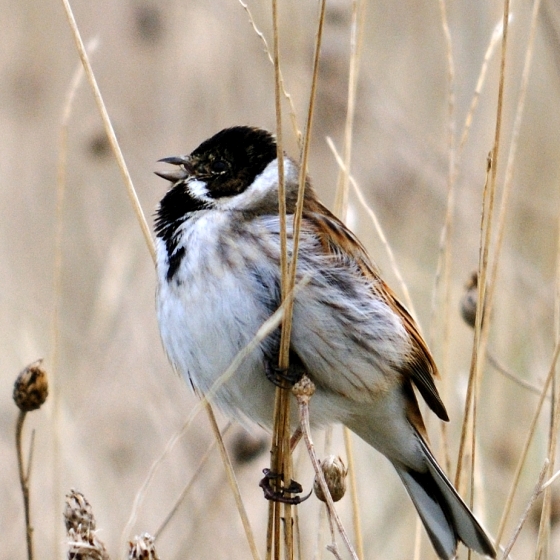Reed Bunting
Emberiza schoeniclus (Linnaeus, 1758)
RB
 REEBU
REEBU  18770
18770

Family: Passeriformes > Emberizidae

Not just a bird of reedbeds, this common species is widely distributed across much of Britain & Ireland throughout the year. It is absent only from the highest upland areas.
The male Reed Bunting has a striking black head with a white moustachial stripe; the female has a browner head, but the moustachial stripe is still visible. When perched, both sexes flirt their tail sideways, showing white outer feathers. The male's buzzing call is distinctive.
In winter, the Reed Bunting often joins other finches and buntings to feed in arable landscapes. At the end of the 20th century, BTO research attributed declines in these species to intensive agriculture reducing food availability over the winter months. This issue has been, to some extent, addressed through agri-environment schemes, and there has been a gradual overall increase in the UK population since the late-1990s. However, the picture is mixed with a significant decline in South-east England.
Exploring the trends for Reed Bunting
Our Trends Explorer will also give you the latest insight into how the UK's Reed Bunting population is changing.
trends explorerIdentification
Reed Bunting identification is often straightforward. The following article may help when identifying Reed Bunting.
Identifying winter buntings

If you find brown, streaky buntings hard to identify, this workshop is for you. Using video footage, still photographs and sound recordings we highlight the differences between four species of bunting that can be found in coastal areas in winter: Reed, Little, Snow and Lapland Buntings.
- 1 of 2
- next ›
SONGS AND CALLS
Listen to example recordings of the main vocalisations of Reed Bunting, provided by xeno-canto contributors.
Call
Song
Develop your bird ID skills with our training courses
Our interactive online courses are a great way to develop your bird identification skills, whether you're new to the hobby or a competent birder looking to hone your abilities.
Browse training coursesStatus and Trends
Population size and trends and patterns of distribution based on BTO surveys and atlases with data collected by BTO volunteers.
CONSERVATION STATUS
This species can be found on the following statutory and conservation listings and schedules.
POPULATION CHANGE
Reed Bunting abundance has fluctuated without a clear trend since the 1980s. The long-term WBS/WBBS trend shows a large decline and raises an alert, contrasting with the long-term CBC/BBS trend. However, the CBC/BBS trend shows a substantial increase in the first eight years until the mid-1970s followed by a substantial decline in the late 1970s and early 1980s, and therefore the trends would be consistent if they had both started in 1975. Results from BBS indicate significant population increase since 1995, though with a downturn from around 2008 to 2012. The BBS map of change in relative density between 1994-96 and 2007-09 indicates that increase over that period was widespread, but strongest in northeastern England, while decrease had occurred in Northern Ireland, Orkney and the far southeast. The initial decline placed Reed Bunting on the red list but in 2009, with evidence from BBS of some recovery in numbers, the species was moved from red to amber. There has been a decline across Europe since 1980 (PECBMS: PECBMS 2020a>).
| UK breeding population |
No population change in UK (1967–2022) 
|
Exploring the trends for Reed Bunting
Our Trends Explorer will also give you the latest insight into how the UK's Reed Bunting population is changing.
trends explorerDISTRIBUTION
Breeding Reed Buntings are widely distributed across Britain and Ireland with gaps confined to the more barren uplands of northern Scotland, including Shetland and some Hebridean islands. Highest densities are associated mostly with large lowland vales and plains. Reed Buntings are mostly sedentary and distribution patterns in winter and the breeding season differ only where birds abandon upland areas in winter.
Occupied 10-km squares in UK
| No. occupied in breeding season | 2507 |
| % occupied in breeding season | 83 |
| No. occupied in winter | 2422 |
| % occupied in winter | 80 |
European Distribution Map
European Breeding Bird Atlas 2
Breeding Season Habitats
| Most frequent in |
Reedbed 
|
Relative frequency by habitat
Relative occurrence in different habitat types during the breeding season.

DISTRIBUTION CHANGE
The breeding distribution has been largely stable since the 1968–72 Breeding Atlas, despite a major population increase and subsequent decline in the 1970s. More recently, increases in abundance are apparent in eastern and northeast England and in southern Scotland, whilst declines are concentrated into southeast England. Some declines are also apparent in eastern Ireland.
Change in occupied 10-km squares in the UK
| % change in range in breeding season (1968–72 to 2008–11) | -5% |
| % change in range in winter (1981–84 to 2007–11) | +24.7% |
SEASONALITY
Reed Bunting is recorded throughout the year, with detections peaking at 20% of complete lists in summer when easily detected by song.

Movement
Information about movement and migration based on online bird portals (e.g. BirdTrack), Ringing schemes and tracking studies.
An overview of year-round movements for the whole of Europe can be seen on the EuroBirdPortal viewer.
RINGING RECOVERIES
View a summary of recoveries in the Online Ringing Report.
Foreign locations of birds ringed or recovered in Britain & Ireland

Biology
Lifecycle and body size information about Reed Bunting, including statistics on nesting, eggs and lifespan based on BTO ringing and nest recording data.
PRODUCTIVITY & NESTING
Exploring the trends for Reed Bunting
Our Trends Explorer will also give you the latest insight into how the UK's Reed Bunting population is changing.
trends explorerSURVIVAL & LONGEVITY
View number ringed each year in the Online Ringing Report
Exploring the trends for Reed Bunting
Our Trends Explorer will also give you the latest insight into how the UK's Reed Bunting population is changing.
trends explorerBIOMETRICS
Wing Length 
|
Adults | 77.8±3.6 | Range 72–83mm, N=17032 |
| Juveniles | 77.3±6.7 | Range 72-82mm, N=14164 | |
| Males | 80.1±2.6 | Range 76–84mm, N=9655 | |
| Females | 74.8±2.1 | Range 72–78mm, N=7258 |
Body Weight 
|
Adults | 19.2±1.8 | Range 16.4–22.2g, N=14380 |
| Juveniles | 18.6±1.7 | Range 16.0–21.5g, N=11985 | |
| Males | 20.1±1.5 | Range 17.8–22.6g, N=8143 | |
| Females | 18.0±1.4 | Range 16.0–20.5g, N=6136 |
Feather measurements and photos on featherbase 
CODES & CLASSIFICATION
Ring size 
|
A (pulli B) |
Field Codes 
|
2-letter: RB | 5-letter code: REEBU | Euring: 18770 |
For information in another language (where available) click on a linked name
Research
Interpretation and scientific publications about Reed Bunting from BTO scientists.
CAUSES AND SOLUTIONS
Causes of change
Detailed demographic analyses suggest that the decline was driven by decreasing survival rates and that a subsequent population recovery may have been prevented by increased nest losses.
Further information on causes of change
The early increase in the CBC index was associated with a gradual spread into drier habitats, especially farmland, and it is likely that the subsequent decline was related to agricultural intensification. Detailed demographic analyses suggest that the decline was driven by decreasing survival rates and that a subsequent population recovery may have been prevented by increased nest losses (Peach et al. 1999). This is supported by a steep decline in CES productivity and by a major increase in failure rates at the egg stage, and a consequent fall in the number of fledglings per breeding attempt. Farmland densities are four times higher in oilseed rape than in cereals or setaside and this crop is crucial in reducing the dependency of the species on wetlands (Gruar et al. 2006).
Information about conservation actions
Like the related Yellowhammer, the research suggests that the main driver of the decline may have been reduced survival and therefore conservation actions to ensure sufficient food is available during winter will be needed to help reverse the decline. However, there is also evidence that increased nest losses may be preventing recovery and so this also needs to be addressed.
During winter, similar conservation actions to those proposed for Yellowhammer and other seed-eating birds are likely to also benefit the Reed Bunting. These include the direct provision of supplementary food, the retention of stubble fields, the planting of wild bird seed or game cover, reducing herbicide and pesticide use, and the provision of semi-natural habitats, e.g. through the provision of buffer strips, set-aside and conservation headlands, and through less intensive farmland management practices.
For Reed Buntings nesting in wetlands, a Swiss study suggested that, in order to reduce the probability of nest predation, wetland reserve management should aim to create larger wetlands and large dense reed patches rather than fragmented habitat (Pasinelli & Schlegg 2006). Away from wetlands, nesting densities in farmland are four times higher in oilseed rape than in cereals or set-aside and therefore this crop is crucial in reducing the dependency of the species on wetlands (Gruar et al. 2006).
Links to more studies from ConservationEvidence.com
- Changes in the breeding bird population of a small clay river following flood alleviation works
- Population trends of breeding birds in the ecologically upgraded Rhine valley (canton of St. Gallen, Switzerland)
- Winter use of wild bird cover crops by passerines on farmland in northeast England
Read more studies about Reed Bunting on Conservation Evidence >
Would you like to search for another species?












Share this page